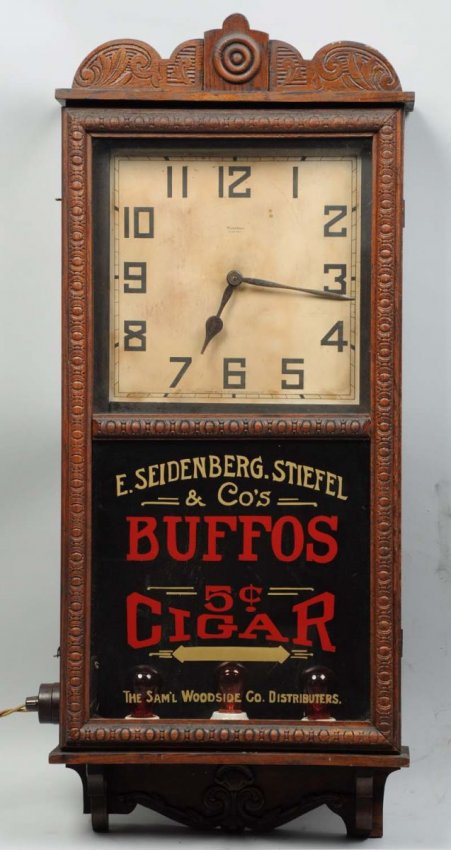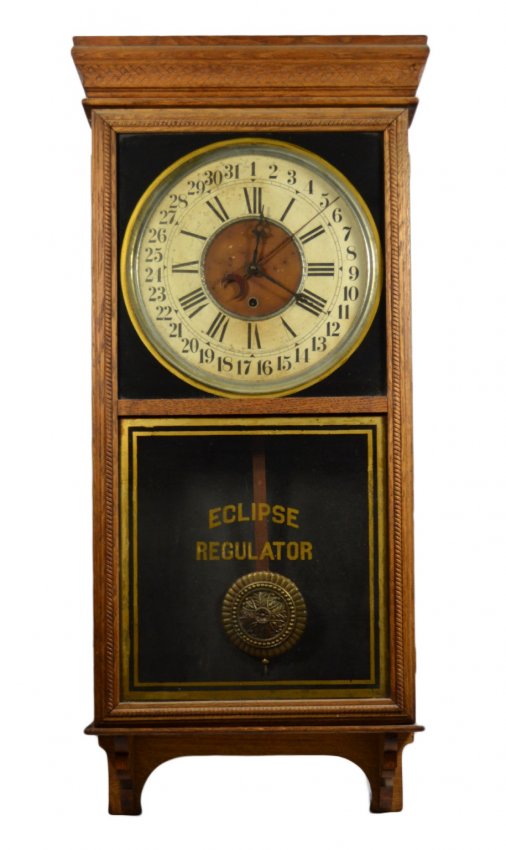Buffos 5¢ Cigar Advertising Clock
Description
Nice Waterbury Electric clock face shows some discoloration from age, etched wood case is very nice, and lower reverse on glass advertisement is in excellent condition. Lower compartment lights up and reads ” E. Seidenberg. Stiefel & Co’s Buffos 5¢ Cigar – The Sam’l Woodside Co. Distributers.” Condition (Very good). Size 37 – 3/4″ x 17 – 1/2″ x 5″
- Estimate:
- Auctioneer:
- Sold Price:
- Sold Date:
Wall Calendar Clock, Eclipse Regulator
Description
Wall Clock
Material: Oak wood
Period: Early 20th Century
Features: The face tells both the date and time. The bottom glass reads “Eclipse Regulator” and the face of the clock reads “Made by The Sessions Clock Co. Forestville Conn. USA.”
Size: 39″ H x 17.5″ W x 5″ D
Weight: 15 pounds
Condition: Good. Face of clock and paint shows wear. This clock operated well upon inspection in the gallery. However, we cannot guarantee operation continues after our initial inspection.
History: The Sessions Clock Company (“Sessions”) was one of several notable American clock companies centered in Connecticut. The E Ingraham Clock Company, the New Haven Clock Company, the Seth Thomas Clock Company, Sessions and its predecessor E.N. Welch Company, and the Waterbury Clock Company collectively produced most of the mechanical clocks made in America between the early 20th century and 1950.About 1900, William E Sessions and other family members purchased a controlling interest in the E.N. Welch Company, a clock manufacturer located in Forestville, Connecticut. Sessions’ father owned a foundry located in Bristol, Connecticut that produced cases for E.N Welch Co. On January 9, 1903, the company was reorganized as The Sessions Clock Company.Within a few years the Sessions Clock Company was producing clock movements, cases, dials, artwork and castings for their line of mechanical clocks. Between 1903 and 1933 Sessions produced 52 models of mechanical clocks, ranging from Advertisers, large and small clocks with logos of various businesses, to wall, or regulator clocks, and shelf or mantel clocks, designed for the home. Many of the Session clocks from this period are prized by collectors.In 1930, the company expanded to produce electric clocks and timers for radios, while continuing to produce traditional brass mechanical movements. Beginning at the end of World War II Sessions W Model (electric) was widely used by various casting companies for their clocks. The dial of the W Model read Movement by Sessions. In the early 1950s Sessions begin to produce timers for television.In 1956, Sessions was absorbed by a company interested mainly in their timing devices. In 1959, William K. Sessions, grandson of William E. Sessions left the Sessions Clock Company and formed the New England Clock Company. In 1960, one of the Sessions Clock buildings was sold to the Bristol Instrument Gears Company.Kept as the Sessions Company, the new owners ran the operation until 1969 when changes in the market forced the Sessions Company into liquidation. In 1970, the remaining buildings were sold to Dabko Industries, a machine parts manufacturer.
Meta: Timepiece, timekeeper, timemarker, watch
- Estimate:
- Auctioneer:
- Sold Price:
- Sold Date:
 ClockPrices.Com
ClockPrices.Com
